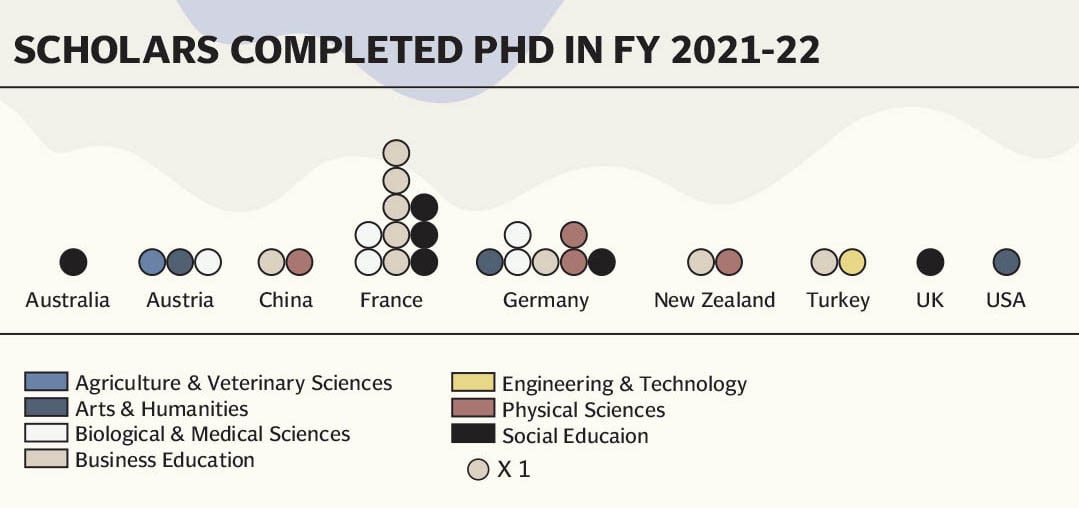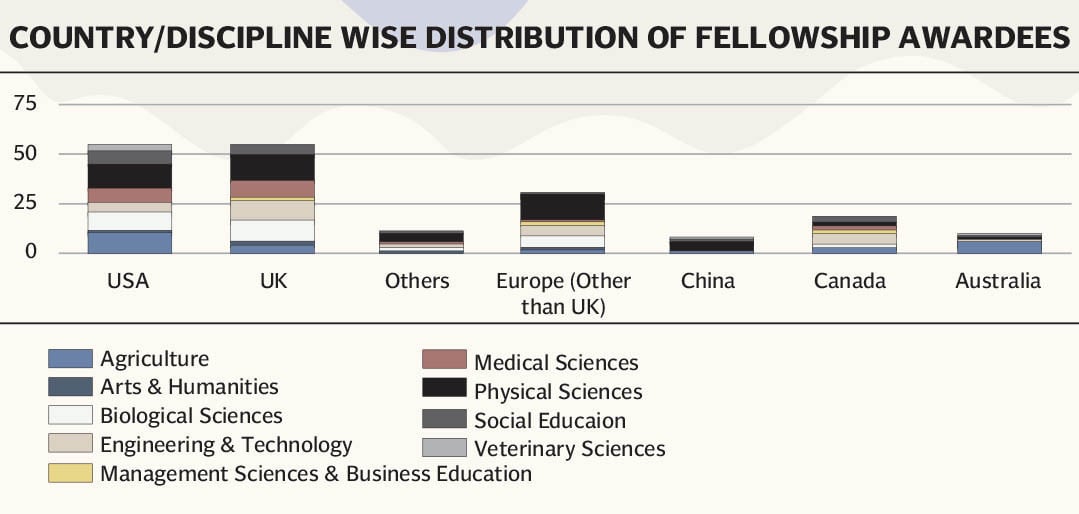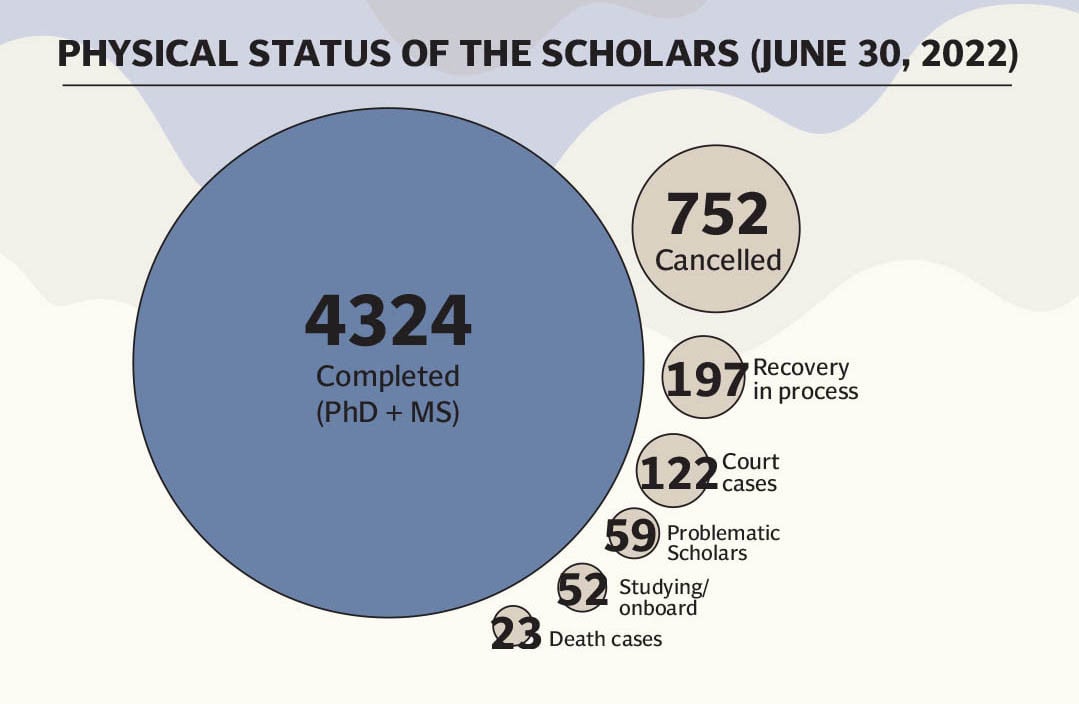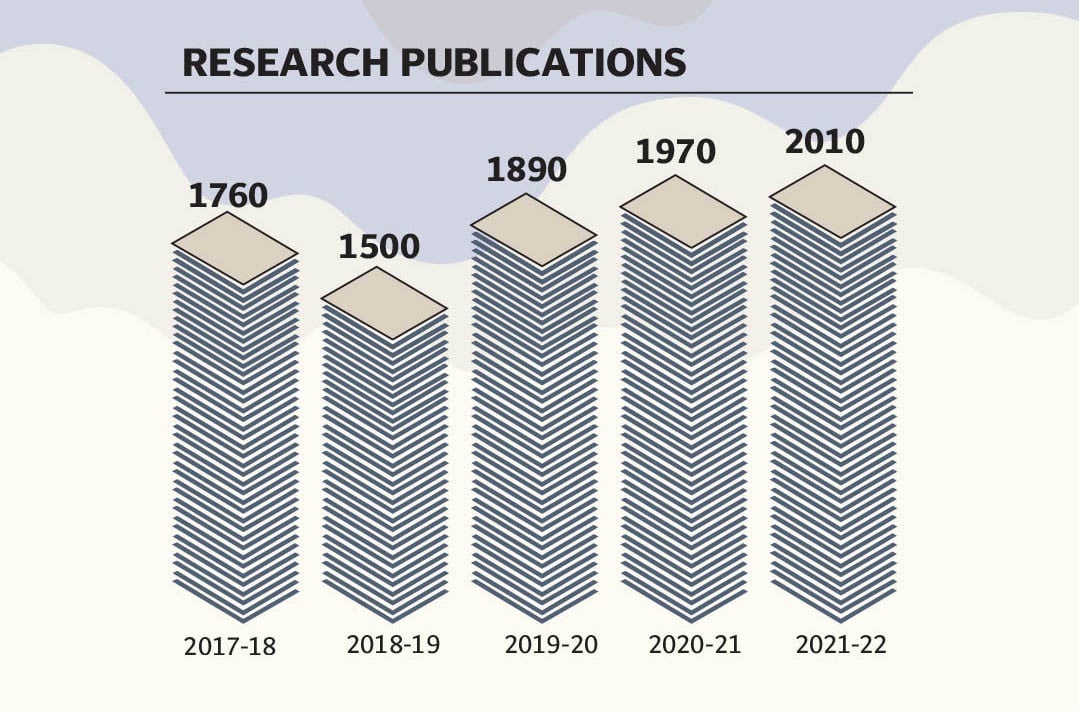The lack of increase in funding for higher education and the cessation of research funds has led to stagnation in the number of PhD students in the country. The shortage of funds in public universities, and a continuous increasing the fees for MPhil/PhD programmes has skyrocketed the cost of a PhD from public universities, taking it from Rs500,000 to Rs1 million or even more in some cases. It is not easy for students to pursue a doctorate degree anymore.
According to the Pakistan Economic Survey of Pakistan 2023/24, the number of individuals pursuing a PhD in Pakistan has hovered around 3,000 over the past three years, with a slight decrease in the year 2022/23.
In addition, higher education indicators in the survey reveal that in 2021/22, a total of 3,076 PhDs were completed in Pakistan. This number increased slightly to 3,271 in 2021/22, but then decreased to 3,035 in 2022/23. These statistics are based on data from the Higher Education Commission (HEC) of Islamabad.
Interestingly the survey claims that the number of PhD graduates reflects a continuous improvement in the quality of higher education in Pakistan. To support this claim, the survey compares the number of PhD graduates in 2002/03, which was recorded at 285, a time when the funding body for public universities was the University Grants Commission. However, it is noteworthy that the higher education indicators from 2002/03 do not include the number of public and private universities in the country. Two decades ago, the number of public and private universities was also limited, and accordingly, the number of PhD graduates was lower. Currently, Pakistan has a total of 263 universities, with 154 in the public sector and 109 in the private sector. These universities have separate sub-campuses as well, and PhD programmes are also conducted at these campuses.

The total number of sub-campuses of universities in Pakistan is 131, with 90 in the public and 41 in the private sector. Despite many private universities being halted, they continue to run PhD programmes in their sub-campuses, leading to a current annual PhD count of around 3,000. The number of students enrolled in public and private sectors during the era of the University Grants Commission is not clear. The survey indicates that there are currently over 1,929,000 students enrolled in universities in Pakistan, and out of these approximately two million students, around 3,000 complete their PhD each year.
The Express Tribune requested Dr Mukhtar Ahmed, the Chairman of HEC who recently completed his second two-year term, and his subordinates for data from the HEC regarding the number of PhD candidates in Pakistan, the number of students completing their PhD each year, in what fields are/were these PhD degrees being awarded, and which universities lead in producing PhD graduates. But despite repeated requests to provide information, initially, Dr Mukhtar Ahmed was reluctant about sharing data and later started avoiding discussions on the matter. No official stance or data was provided by HEC, raising questions about why the number of PhD candidates in Pakistan has dwindled over the past three years.
In Pakistan, individuals pursuing a PhD fall into at least two categories. One category includes those who are involved in teaching and are part of the university faculty. For these individuals, job progression or grade advancements are contingent upon completing a PhD. Thus, university teaching faculty members are keen on completing their PhD as it is essential for their career advancement from lecturer to assistant professor.
The other category includes individuals or students who seek to enhance their professional skills through research related to their respective fields. However, both categories confront the challenges of short funding and increase in fees for pursuing a PhD. A vice-chancellor of a government university in Sindh said in an interview with the daily Express that the HEC used to have an indigenous PhD fellowship programme that students would apply for and a large number of students funded their PhD expenses through this programme that included fees and funds for books. The vice-chancellor mentioned that while this programme may still be available for existing students, it is no longer being offered to new students. Consequently, the entire burden now falls on the students themselves.
It is noted that since 2018, the federal government has not increased the non-developmental grant for public universities, which has remained at Rs65 billion rupees for the last six fiscal years. Meanwhile, the estimated expenses for universities suggest that the HEC requires at least Rs125 billion annually. Due to the lack of increase in the grant for public universities, these institutions have been continuously raising their tuition fees every year. These tuition fee hikes are occurring not only at the undergraduate level but also for MPhil/PhD programme.

Universities argue that if they do not increase these fees, they will not be able to cover their expenses, as federal and provincial governments are increasing salaries and pensions in the budget each year, while electricity tariffs and other costs are also increasing. However, when there is an increase in admission and semester fees at the PhD level, it directly impacts the students, as generally, PhD-level expenses were borne by the students themselves.
Nevertheless, despite HEC Islamabad's avoidance of data sharing regarding PhD statistics, the Express Tribune obtained data about PhD and non-faculty positions from Pakistani universities. According to this data, there are 61,211 faculty members in Pakistani universities, with more than 64 per cent of the faculty being non-PhD, while 35.46 per cent hold PhDs. The statistics show that there are 39,502 non-PhD faculty members and 21,702 PhD faculty members.
In almost every province, the number of non-PhD faculty is higher. In Sindh, there are 10,725 non-PhD and 3,828 PhD faculty members. Similarly, in Punjab, there are 14,382 non-PhD and 8,002 PhD faculty members. In Khyber-Pakhtunkhwa, there are 4,501 non-PhD and 3,827 PhD faculty members. In Balochistan, there are 1,808 non-PhD and 601 PhD faculty members. In Azad Jammu and Kashmir, there are 1,032 non-PhD and 415 PhD faculty members. In the federal capital, there are 6,912 non-PhD and 4,921 PhD faculty members. In Gilgit-Baltistan, there are 142 non-PhD and 108 PhD faculty members.
For a regional comparison, take the position of PhDs in Bangladesh – according to the country’s Bureau of Statistics, there were 51,704 PhD holders in the 2022 census. According to the University Grants Commission of Bangladesh, there were 5,606 PhD faculty members at local universities by 2021, up from 4,766 in 2017. Between 2017 and 2021, 4,433 students obtained their PhD degrees from 27 universities. Bangladesh has a total of 56 universities.
Since the outgoing Chairman of HEC did not provide any statement or data regarding this situation, the Express Tribune questioned Rana Mashhood, chairman of the Prime Minister's Youth Programme, during his visit to the University of Karachi, about the federal government's continuous lack of increase in higher education funds and the decreased number of PhD holders. He directed the question to the previous federal government, questioning them about as to why it did not increase higher education funds during its tenure.
Mashhood stated that during the caretaker government's period, there was a proposal to completely cut off higher education funds for provinces. However, the new government disagreed, and the Prime Minister decided to restore the previous funds. According to him, the aim now is to increase this funding in the upcoming budget.

Pushed abroad
“Our youth are increasingly concerned about unemployment and economic uncertainty, prompting many to pursue education abroad due to dissatisfaction with the quality of education in their home country,” points out Dr Muhammad Shabbir Sarwar, Associate Professor, Punjab University, and a doctorate in media studies. “They feel that the local education system does not adequately prepare them for the competitive global job market, which requires strong skills and practical experience. They prefer to go abroad for higher education instead of doing doctorate in Pakistani universities.”
Dr Sarwar believes it is tragic that brain drain continues to be a significant issue in the country, yet the government seems to be in denial about the problem. “Our policymakers dismiss it, claiming that those who leave will eventually send back foreign exchange,” he says. “However, many of our brightest minds, after earning advanced degrees abroad, choose to remain in those countries rather than returning home. Instead of contributing to our nation’s progress, they end up driving the development of other countries. It’s a loss we can’t afford to overlook. Apart from this, when they take reference letters from us, they take away valuable foreign exchange with them. They say they are going to get education after selling their inheritance plots or spending the family’s savings. There has been a capital flight of billions of dollars from the country in the last several years because of this situation, but no attention has been paid to the issue and capital flight and brain drain from the country continues.”
It has been reported in the media that five young people have completed their PhD in the police department, but all they have been offered is a clerical position or a constable’s position.

“Every year a large number of university graduates are going to foreign universities in Ukraine, Korea, England, Australia, China, Germany, Canada, Central Asian countries, the US and other countries for higher education or doctorate,” says Dr Sarwar. “Their aim is to settle down abroad after studying there as in Pakistan they do not see any benefit in the form of research or job. Students in these countries are earning a lot of foreign exchange. You can see that on a daily basis young people apply for visas to other countries. We need to set up industries in the country and use this valuable talent.”
Our universities should be ranked in such a way that students from other countries come here to get education. There should be industry here to absorb that talent. Giving them employment and privileges will protect capital flight and brain drain. “Previously, the government used to pay the foreign surveyor's fee to the universities which was Rs50,000,” points out Asim Hafeez, a PhD student. “But now this fee has increased to Rs250,000, while the annual fee has also been increased. The students just end up in a financial turmoil.”
On the other hand, the government does not show much interest in students doing PhD in Punjab University and other universities. Hence, there been any significant progress in the education sector for the students, nor has a great mind emerged in the country in economics, politics and social sector.
Punjab, which is the largest province in terms of population, has a population of 120.5million, the highest number of youth, and 32 official universities in its education sector, out of which 28 universities have not yet appointed regular vice-chancellors.
Surprisingly, none of the universities have any data from the HEC to show how many children have obtained PhD from the universities of Punjab. In this regard, some data has been collected from some universities of Punjab and sources of higher education, according to which 168 students have obtained PhD degree from University of Education Lahore, while 13 from University of Information, 872 from Bahauddin Zakariya University Multan, 11 from Forman Christian University, 723 from Government College University, 3,767 from Punjab University, University Of Engineering and Technology 391, 387 from the University of Veterinary and Animal Sciences, and 15 students from Lahore College for Women University have got PhD degrees.

High risk, no reward
Muhammad Mashood is also one of the thousands of students who were discouraged during his PhD. Consequently, he rolled back his research and now runs a business in Islamabad.
“If your supervisor is not supportive while you are researching, you will struggle to complete your PhD,” he says, sharing how thousands of students quit their PhD due to their supervisor and other non-cooperative staff on top of financial issues that they have to deal with.
According to a Governor House Peshawar analysis, not a single student has been enrolled in PhD programmes at several universities during the last three years. The report says that out of 11 universities in Khyber-Pakhtunkhwa, not a single student was enrolled in the last three years in PhD programmes.
These universities include the University of Shangla, University of Veterinary and Animal Sciences, University of Agriculture Swat, Shuhada-e-APS University of Technology, Nowshera, FATA University, FR Kohat, University of Buner, Women University Swabi, Women University Mardan, University of Engineering and Applied Sciences Swat, University of Agriculture D .I. Khan and University of Chitral.
The KP Universities 2021-24 Report reveals that the initial balances of budgets of 34 public sector universities and HEI’s, which was Rs6,560 million in 2021-22 has been decreased to Rs5,316 million in 2022-23 and was further slashed to Rs4,740 million in 2023-24.
In the fiscal year 2023-24, the total expenditure of all 34 universities reached to Rs41 billion, against which only Rs1 billion was earmarked for research initiatives. This extremely low budget shows the inclination of the government towards research.
The report further shows that in the fiscal year 2023-24, the total expenditure reached to Rs.40,796 million while only Rs.1,197 million was earmarked for research initiatives across 34 universities. The allocation constitutes approximately three per cent of the overall budget of Rs41 billion as this proportion highlights the priority given to research within the financial framework.
According to a document from the Governor’s secretariat, the total PhD faculty across KP in 2021-22 was 2678. In 2022-23, it was 3074 and in 2023-24, the number reduced to 3528. Similarly, the total non-PhDs faculty in 2021-22 was 2276, in 2022-23 it was 2205, while in 2023-24 it was 2334.
The report further added that the total PhD student enrollment in 2021-22 was 3339, in 2022-23 it was 3735, and in 2023-24 it was down to 4432 students.
“Presently, PhD is completed like eating a bowl of popcorn,” says Dr Muhammad Uzair, the president of Peshawar University Teachers Association, as he elaborated on students who were doing research in the university lab paid for it, while sometimes the students paid their foreign examiners as the university was unable to pay them.
He emphasised that unless the government increased the budget and facilities for research, research studies in our country will not improve and Pakistan will not be able become a developed nation.
